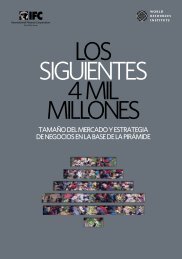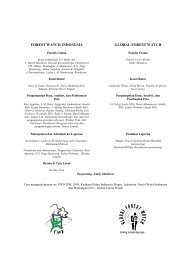GLObAL COAL RISK ASSESSmENT - World Resources Institute
GLObAL COAL RISK ASSESSmENT - World Resources Institute
GLObAL COAL RISK ASSESSmENT - World Resources Institute
Create successful ePaper yourself
Turn your PDF publications into a flip-book with our unique Google optimized e-Paper software.
Long rail distances and inadequate railway capacity have<br />
doubled the cost of inland coal transport in Russia over<br />
the past few years, making Russian coal less competitive<br />
in the global market. 61 From 2008 to 2030, railway<br />
infrastructure investments will amount to US$55.5<br />
billion. Five routes are targeted: the Hinterland connection<br />
between Novorossiysk and Tuapse, new rail lines<br />
between Ust-Luga and St. Petersburg, connecting mines<br />
in the North Ural to Northwest ports, capacity extension<br />
in Siberia, and the area around Vanino. 62<br />
Most of the ports for Russian coal exports are located<br />
in three regions: North Russia (the Baltic Sea Ports of<br />
Murmansk, Vysotsk, Riga, Ventspils, Tallin, St. Petersburg,<br />
and Ust-Luga); South Russia and Ukraine (Mariupol,<br />
Tuaspse, and Yuzhny); and Far Eastern Russia<br />
(Vostochny, Vanino, and Muchka). Coal exports through<br />
the Baltic ports have dropped due to high transit fees<br />
levied by the Baltic States, but have increased through the<br />
Far East ports. 63 The seaports of Vanino, Vostochny, and<br />
Nakhodka serve an important role in maintaining trade<br />
with Japan and South Korea.<br />
To respond to strong demand growth in China and India,<br />
port capacity in the Far East will be further enhanced.<br />
Vanino, the second largest coal port in Russia, will update<br />
its handling capacity from 13.5 Mtpa to 18.5 Mtpa by<br />
2013. The port of Posiet is also expanding, from 5 Mtpa to<br />
between 7 and 9 Mtpa by the end of 2012. In total, Russian<br />
export terminal capacity is projected to increase by about<br />
13 Mtpa over the next five years. 64<br />
Kazakhstan<br />
Kazakhstan exports around 30 to 35 percent of its total<br />
coal production. Most of Kazakhstan’s exported coal is<br />
destined for Russia, but some is destined for a small number<br />
of European countries. 65<br />
Kazakhstan has the world’s third-largest open pit mine:<br />
the Bogatyr mine, in the Ekibastuz Basin in northern<br />
Kazakhstan. Bogatyr has a reserve of around 10 billion<br />
tonnes of coal. Another massive coal basin is near Karaganda,<br />
at the center of the country. With numerous other<br />
smaller deposits, Kazakhstan has recoverable coal reserves<br />
of around 34 billion tonnes, placing it among the world’s<br />
top-10 producers. Coal production is expected to reach 134<br />
Mtpa by 2015 and 151 Mtpa by 2020. Exports will increase<br />
from the current 20 to 22 Mtpa, to 32 Mtpa in 2014. 66<br />
Global Coal Risk Assessment<br />
Each of Kazakhstan’s major coal producing companies<br />
has announced plans to increase its output. Bogatyr Coal<br />
is planning to nearly double its production by 2020. The<br />
energy division of ENRC, Kazakhstan’s largest metals<br />
company and one of the largest producers of electricity and<br />
coal in the country, increased coal production to 20.1 Mtpa<br />
in 2010. Between 2011 and 2015, ArcelorMittal, which has<br />
eight coalmines in the Karaganda region, is investing some<br />
US$300 million to expand its coal capacity. 67<br />
mongolia<br />
The recent development of coal mining and exporting in<br />
Mongolia has significantly boosted its economy. In 2011,<br />
32.99 million tonnes of coal was mined and 25.5 million<br />
tonnes exported, making coal the country’s leading export<br />
product. Recognizing the global demand for coal, especially<br />
from Asia, the Mongolian government has prioritized<br />
the coal industry for the past several years. 68<br />
As a landlocked country, Mongolia must build new<br />
transport infrastructure to deliver its coal to the Chinese<br />
and Russian markets. The Mongolian Government has<br />
announced plans to cooperate with the governments of<br />
Russia and China to resolve these transport challenges.<br />
Russia and Mongolia collaborated on the second phase<br />
of a railway project in Mongolia. Russian Railways helps<br />
transport Mongolian coal from Naushki station, on the<br />
Mongolian border, to Far East ports and other points in<br />
the world. 69<br />
The distance from Mongolia to the Chinese port of Tianjin<br />
is much shorter than the distance to the Russian seaports.<br />
However, in addition to poor road and rail infrastructure,<br />
inadequate border crossing capacity hampers<br />
transport from Mongolia to China. In the South Gobi<br />
region, coal mined by one the largest coal companies<br />
in Mongolia is transported to China through the Shivee<br />
Khuren-Ceke border, where crossing infrastructure was<br />
recently expanded. 70<br />
North Korea<br />
Most North Korean coal is exported to China. 71 One of<br />
North Korea’s largest coal mines is located in Jikdong,<br />
Suncheon-si, Pyongannam-do, and is managed by the<br />
Shuncheon District Coal Company and the Ministry of<br />
Coal Industry. The mine is designed for a capacity of<br />
1 Mtpa, and the current production is around 30,000<br />
tonnes per annum (tpa). A 100 km railway delivers coal<br />
from Shuncheon to Nampo Port. 72<br />
WORKING PAPER | November 2012 | 17











